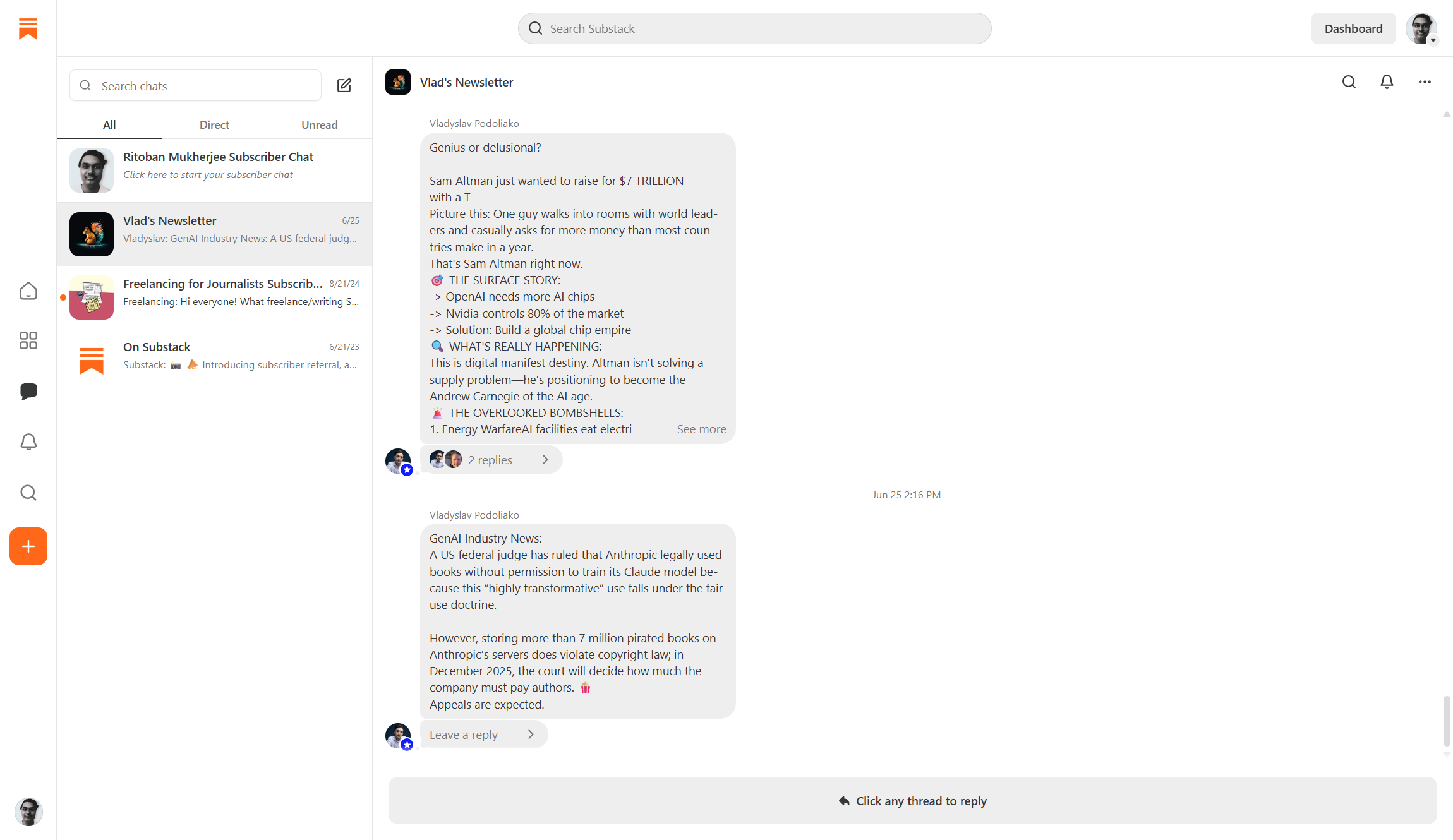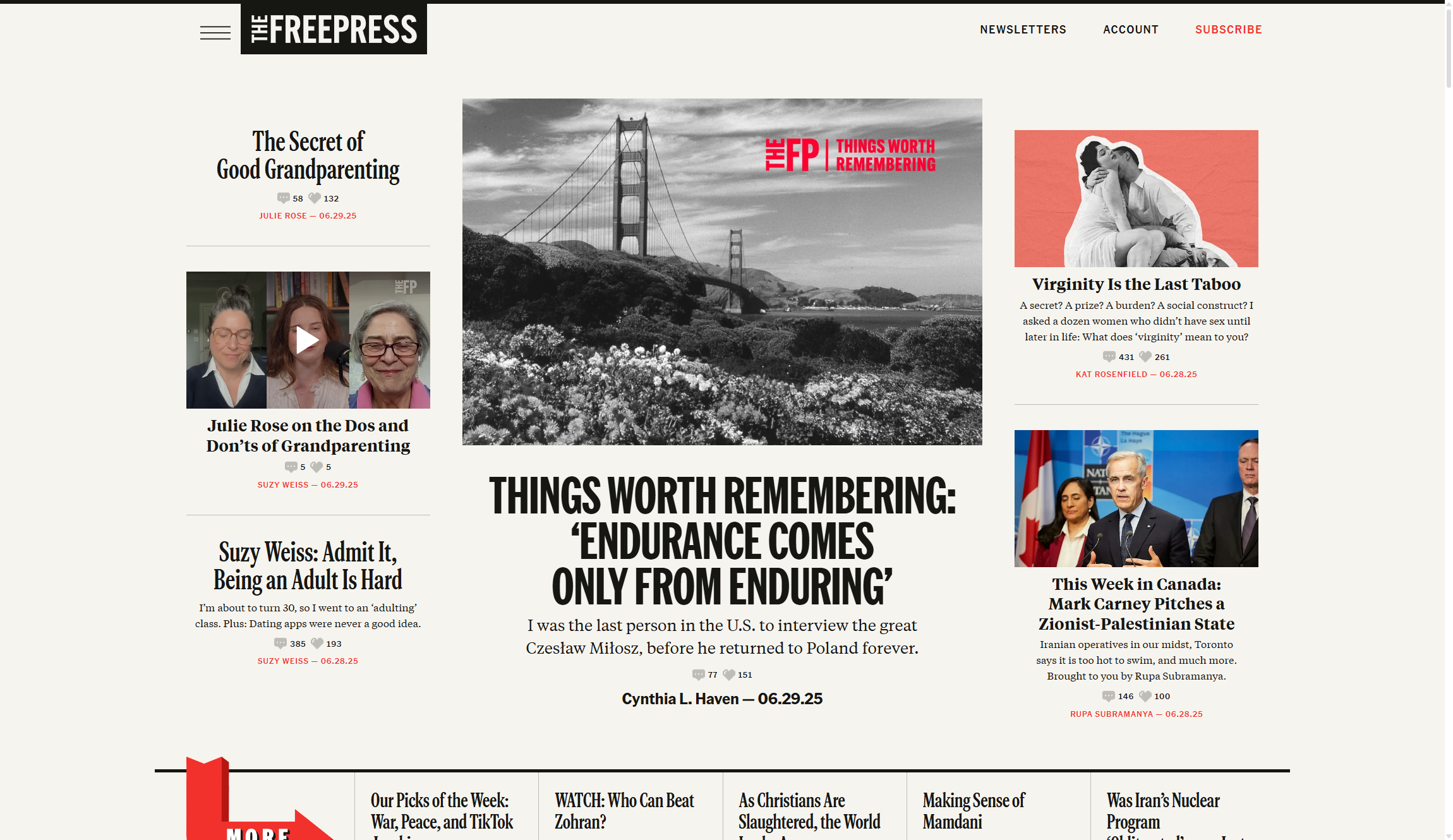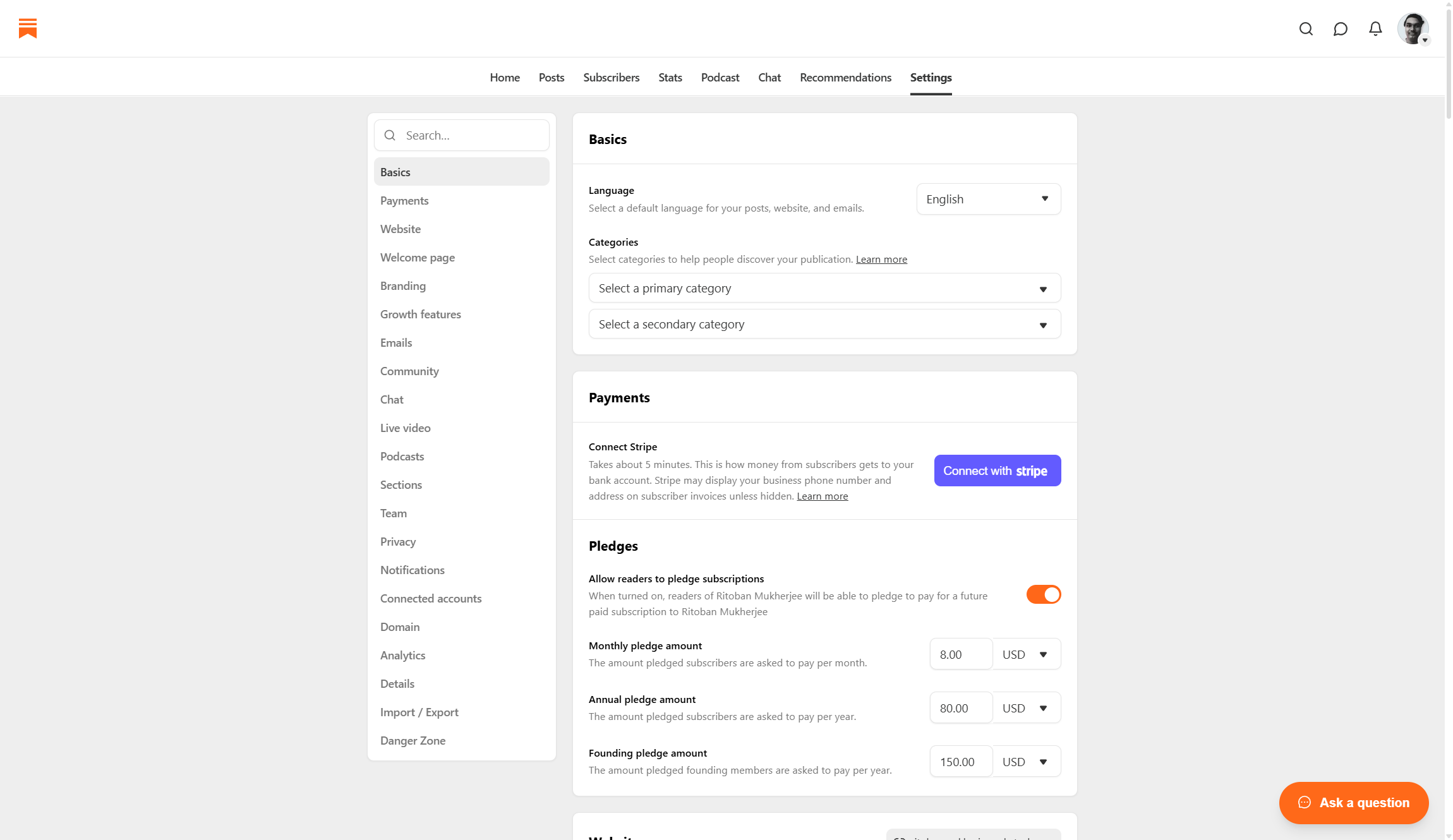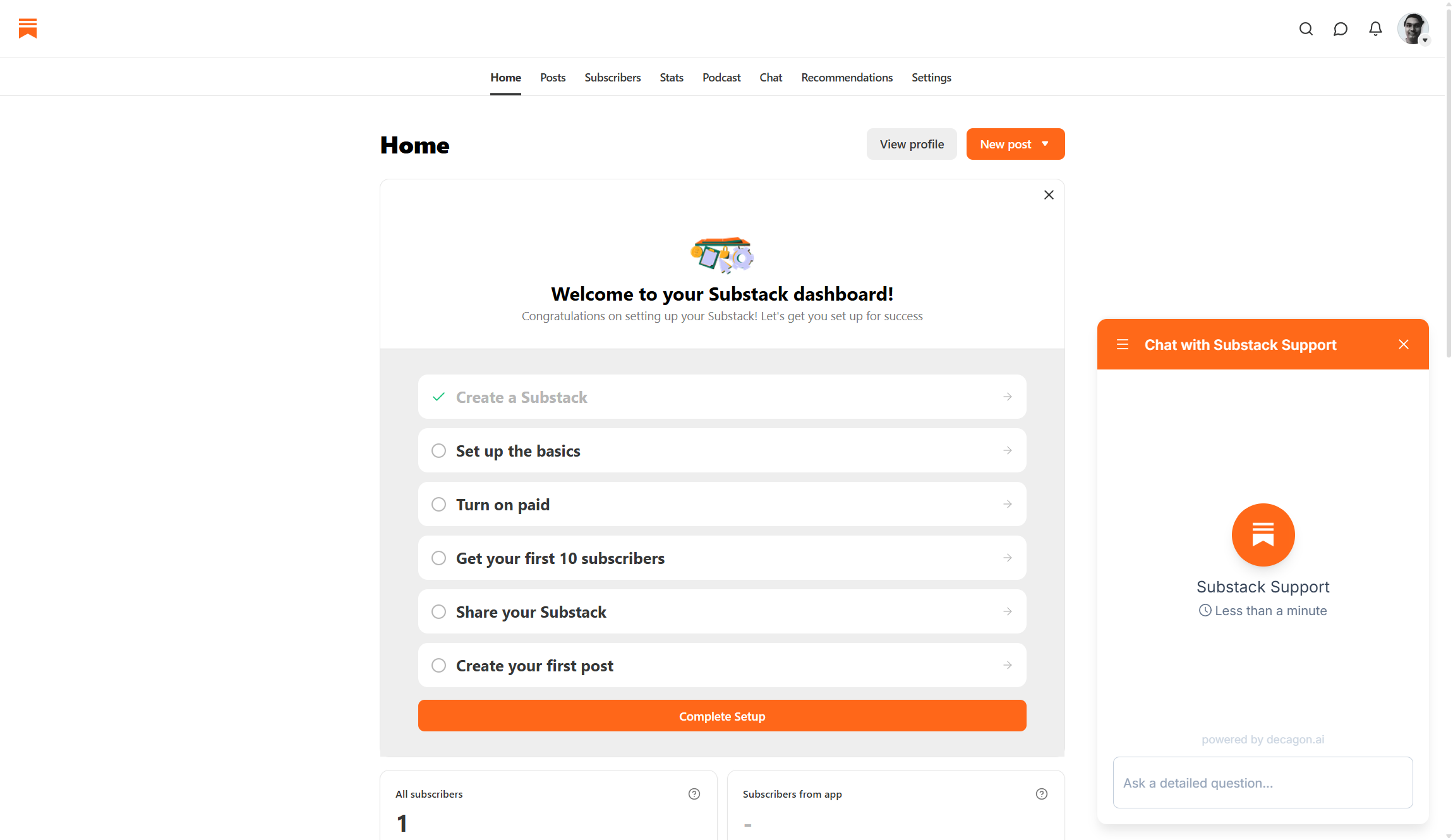Substack has been a genuine surprise among blogging platforms in 2025, aimed for writers who want to ditch the search and monetize their content directly. Unlike some conventional options featured in our best blogging platforms roundup, Substack focuses on newsletter subscriptions and social discovery over traditional SEO. This unique publishing experience has gained significant traction among independent creators, especially journalists and influencers.
Our reviewers have spent thousands of hours testing 140+ of the best website builders and blogging tools, giving us deep insight into what makes platforms succeed or fail. While Wix remains our top pick for overall blogging excellence in 2025, Substack carves out its own niche with a distinctly different philosophy. It prioritizes simple publishing workflows and direct reader relationships over complex features and design flexibility.
Substack's growth trajectory has been remarkable, with writers building substantial audiences and generating significant revenue through paid subscriptions. Its success stems from its focus on quality content and genuine reader engagement, creating an environment where thoughtful writing thrives over algorithm-chasing tactics.
What is Substack?
You can think of Substack as a hybrid between a blog and an email newsletter service, designed specifically for writers who want to build direct relationships with their readers.
At its core, Substack is a content publishing platform where you can share newsletters and monetize your writing. Unlike traditional blogging platforms that rely heavily on search engine traffic, Substack delivers your content directly to subscribers' inboxes while also maintaining a web presence for broader discovery.
This platform operates on a simple premise: writers create content, readers subscribe to receive it via email, and successful creators can charge for premium subscriptions. Substack handles all the technical aspects — payment processing, email delivery, subscriber management — so writers can focus purely on creating content. This unique model has attracted everyone from independent journalists to niche experts who want to build sustainable businesses around their expertise, without dealing with complex website management or marketing automation tools.
Features

Substack offers a focused feature set that prioritizes writing and reader engagement over extensive customization options. The platform provides essential tools for content creation, email distribution, basic analytics, and monetization, making it particularly well-suited for writers who want to start publishing immediately without technical barriers. While feature-rich compared to basic newsletter services, Substack deliberately keeps things simpler than full-featured content management systems, which may disappoint users looking for advanced functionality.
The pricing structure reflects this streamlined approach. Core features like writing, publishing, email distribution, notes, videos, podcasts, and analytics are completely free. You only pay when you start earning through paid subscriptions, with Substack taking a 10% platform fee plus payment processing costs. This model makes it accessible for beginners while scaling costs with success, though the lack of advanced email marketing features like segmentation and automation may limit monetization potential for experienced marketers.
Writing and publishing tools
Substack's editor focuses on clean and distraction-free writing with basic formatting options that keep content readable and professional. The platform supports multimedia content including images, videos, and embedded podcasts, allowing creators to build rich publications without technical complexity. Publishing is instantaneous. You write, hit publish, and your content goes live on your profile page and optionally hits subscriber inboxes.
Email newsletter system
Email functionality forms Substack's backbone, automatically formatting your posts for inbox delivery with professional templates. Subscribers receive posts directly in their email, creating more intimate reader relationships than traditional blog followers. The system handles subscriber management, delivery optimization, and basic segmentation between free and paid subscribers. But it lacks advanced email marketing features like automated sequences or detailed subscriber tagging.
Monetization features
Substack's subscription system allows writers to offer free content alongside premium paid tiers, with flexible pricing for monthly, annual, and founding member subscriptions. The platform handles all payment processing through Stripe integration, manages subscriber access to paid content, and provides revenue analytics. Writers can experiment with different pricing strategies and offer various subscription benefits, though the system lacks sophisticated pricing experiments or advanced subscriber lifecycle management.
Community and discovery tools
Substack Notes functions as the platform's social layer, allowing writers to share shorter thoughts and engage with other creators' content. The Recommendations feature enables cross-promotion between compatible publications, creating organic growth opportunities within the Substack ecosystem. These community features help writers discover audiences and build relationships with peers, though discoverability remains challenging for new creators without existing audiences.
Analytics and insights
Basic analytics cover essential metrics like open rates, click-through rates, subscriber growth, and revenue tracking. The dashboard provides clear insights into content performance and audience engagement, helping writers understand what resonates with their readers. However, the analytics remain relatively simple compared to advanced email marketing platforms, lacking detailed subscriber behavior tracking or sophisticated conversion analysis.
Ease of use

Substack excels in simplicity, offering perhaps the most straightforward onboarding experience among content platforms. New users can create an account and publish their first post within minutes, with no technical setup required. The minimal interface eliminates the overwhelming array of options that plague traditional blogging platforms, allowing writers to focus on content creation rather than configuration.
Your writing experience feels natural and distraction-free, with a simple editor that handles formatting automatically while maintaining professional appearance. Publishing requires just a single click, the platform handles email distribution, web posting, and subscriber notifications seamlessly. This extends to subscriber management, where basic analytics and payment tracking remain accessible without complex dashboards or confusing metrics.
However, simplicity comes with trade-offs that some users find limiting. Customization options are minimal. You can adjust colors, add a logo, and choose from basic layouts, but advanced design control simply doesn't exist. Writers who want unique branding or complex page layouts will find Substack restrictive compared to platforms like WordPress or Ghost.
The platform occasionally suffers from performance issues too, with some users reporting unresponsive pages during editing sessions. While these technical hiccups don't affect the core publishing experience, they can frustrate users trying to customize their publications or manage subscriber settings. Despite these limitations, most writers appreciate the focus on content over complexity, finding it liberating rather than restrictive.
Pricing

Swipe to scroll horizontally
Plan | Starting rate (paid annually) | Renewal rate (paid annually) |
Free | $0/month | $0/month |
Pro | 10% of subscription revenue + processing fees | 10% of subscription revenue + processing fees |
Substack operates on a unique revenue-sharing model with no traditional subscription tiers. The platform is completely free to use for publishing free content, regardless of subscriber count.
Writers only pay when they enable paid subscriptions, at which point Substack takes a 10% platform fee plus payment processing costs through Stripe (2.9% + $0.30 per transaction, plus 0.5% for recurring billing). You also pay a one-time fee of $50 if you’d like to connect your own domain, which can be purchased separately from a domain registrar.
This aligns Substack's success with creator success. It only profits when writers earn money. For a typical $50 annual subscription, total fees would amount to approximately $7.10, leaving writers with around $42.90. While a percentage-based model can become expensive for high-earning creators compared to flat-rate alternatives, it eliminates upfront costs and makes the platform accessible to writers just starting their monetization journey.
Customer support

Substack's customer support has become a significant pain point for many users, with the platform heavily relying on AI-powered chatbots in 2024-25. The company launched an automated support system in early 2024, claiming it resolves over 90% of user inquiries. However, user experiences tell a different story, with many reporting frustrating interactions and difficulty reaching human representatives.
The primary support channel is a chatbot that appears on Substack's support page, though users can still email [email protected]. While Substack claims there's a "seamless handoff" to human support when needed, many users report getting stuck in automated loops without receiving actual human assistance. The platform does provide a phone number (415-592-7299), but customer satisfaction ratings are extremely low at just 1.4 out of 5 stars on TrustPilot.
Real user experiences reveal significant issues with the support system. People report being charged multiple times for subscriptions, unable to cancel payments, and receiving only automated responses despite repeated attempts to reach human support. AI sometimes fabricates email addresses or provides incorrect information, leaving users without resolution for weeks or months. Only about 10% of callers manage to speak with an actual person, with the average resolution rate being just 1%.
For urgent security issues, you can contact [email protected], which appears to receive more attention than general support requests. However, the overall support experience remains frustrating for most users, with many describing it as "nonexistent" and recommending alternative platforms partly due to these service limitations.
Alternatives
Substack occupies a unique position in the content publishing market as a hybrid newsletter-blog platform focused on direct reader monetization. While competitors like WordPress offer more customization and Ghost provides better technical control, Substack's strength lies in its social publishing features and built-in community elements. The platform combines traditional newsletter functionality with social media-style interactions through Notes, recommendations, and cross-promotion features that most competitors lack.
For writers seeking maximum customization and control, WordPress remains the strongest alternative, offering extensive themes, plugins, and the ability to sell various digital products beyond subscriptions. Ghost CMS appeals to technically-minded creators who want full ownership without revenue sharing, providing advanced analytics and automation features that Substack lacks. Beehiiv and ConvertKit serve writers focused purely on email marketing with sophisticated automation tools.
Substack works best for independent writers and journalists who prioritize simplicity over customization and want to build direct relationships with readers. It particularly suits creators who appreciate the social discovery aspects and don't need complex email marketing features. However, writers requiring advanced design control, detailed analytics, or diverse monetization options may find better fits elsewhere.
The competitive landscape shows Substack maintaining its lead through community features rather than technical superiority. While platforms like MailerLite offer more comprehensive email tools and Gumroad provides broader monetization options, none match Substack's combination of publishing simplicity and social discovery. This positioning makes Substack ideal for content creators who want to focus on writing rather than platform management.
Substack review: Summary
Substack succeeds as a streamlined publishing platform that removes technical barriers between writers and their audiences. The platform's greatest strength lies in its simplicity. Writers can start publishing and monetizing immediately without dealing with complex setup, payment processing, or email delivery systems. The built-in social features like Notes and recommendations create genuine discovery opportunities that traditional blogging platforms lack, while the direct subscription model aligns creator and platform incentives effectively.
However, Substack's limitations become apparent for creators seeking growth beyond basic newsletter publishing. The minimal customization options, basic analytics, limited SEO capabilities, and problematic customer support create significant constraints for serious content businesses. Writers who need advanced email marketing features, detailed subscriber insights, or professional design control will quickly outgrow what Substack offers, making it hard to recommend as a long-term publishing solution for ambitious creators.
Substack: FAQs
Can I use my own domain with Substack?
Yes, Substack allows custom domains for your publication, giving you a more professional appearance and helping with branding. You can set up a custom domain through your Substack settings, though you'll need to purchase the domain separately and configure DNS settings. This feature helps maintain your brand identity and makes your publication look more established to potential subscribers.
How much does Substack cost for creators?
Substack is completely free to use for publishing free content with unlimited subscribers. You only pay when you enable paid subscriptions, at which point Substack takes a 10% platform fee plus payment processing costs (approximately 2.9% + $0.30 per transaction through Stripe). This means for a typical $50 annual subscription, you'd pay around $7.10 in total fees, keeping roughly $42.90. There are no upfront costs or monthly subscription fees.
Can I export my subscriber list from Substack?
Yes, you own your subscriber list and can export it at any time through your Substack dashboard. This includes both free and paid subscriber information, ensuring you're not locked into the platform. The export feature gives you flexibility to move to other platforms if needed, though you'll need to handle the technical migration and payment processing setup elsewhere.
Does Substack help with content discovery?
Substack offers several discovery features including Notes (short-form social content), recommendations between publications, and curated lists that can boost visibility. However, discoverability remains challenging for new creators without existing audiences. The platform's algorithm-based discovery is limited compared to social media platforms, making it essential to bring your own audience or actively participate in the Substack community to gain traction.
What content formats does Substack support?
Substack supports various content formats including written posts, images, videos, podcasts, and embedded media. You can publish both long-form newsletter content and short-form Notes, create podcast series, and include multimedia elements in your posts. However, the platform lacks advanced formatting options and design flexibility compared to traditional blogging platforms, keeping the focus on clean, readable content rather than complex layouts.










 English (US) ·
English (US) ·